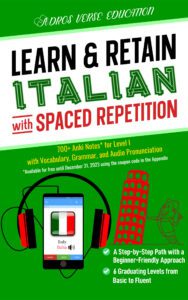Grammarians classify sentences in Arabic into two main categories:
- Nominal sentences
- Verbal sentences
Nominal Sentence vs. Verbal Sentence in Arabic
A nominal sentence is a sentence that starts with a noun, known as مُـبْـتَـدَأ (mubtada’) ‘topic,’ which acts like the subject in English. The second part of the sentence, known as خَـبَـر (khabar) ‘predicate,’ provides information about the مُـبْـتَـدَأ (mubtada’) ‘topic.’ The predicate can take the form of a noun, adjective, verb, verbal sentence, or prepositional phrase.
Remember that in Arabic the verb “to be” is omitted in the present tense. Unless the predicate takes the form of a verb or verbal sentence, nominal sentences in Arabic typically lack a verb.
Here are some examples:
| .الـكِـتـابُ مُـفـيـد al-kitābu mufīd. The book (is) useful. | .الـكِـتـابُ فـي الْـبَـيْـت al-kitābu fī-l-bayt. The book (is) in the house. | .الـكِـتـابُ يُـسَـلّـي al-kitābu yusallī. The book entertains. |
Notice that in the first and second examples, the sentence does not contain a verb in Arabic. The third example constitutes a nominal sentence in Arabic, even though it contains a verb as its predicate, because it starts with a noun.
Grammatically, both the مُـبْـتَـدَأ (mubtada’) ‘topic’ and خَـبَـر (khabar) ‘predicate’ are مَـرْفـوع (marfū‘) ‘nominative.’
Consider the first example above:
| الـكِـتـابُ مُـفـيـدٌ٠ al-kitābu mufīd(un). The book (is) useful. |
In this example, the topic and predicate are nouns or adjectives. Thus, the topic الـكِـتـابُ (al-kitābu) ‘the book’ ends with a ضَـمَّـة (ḍammah) ‘short u’ because it is a definite noun, whereas the predicate مُـفـيـدٌ (mufīdun) ‘useful’ ends with a تَـنْـوين ضَـمّ (tanwīn ḍamm) because it is an indefinite noun. When a word is at the end of the sentence, the final vowel is typically not pronounced. In this case, مُـفـيـدٌ (mufīdun) is pronounced مُـفـيـد (mufīd), with the final ‘un’ sound omitted.
A verbal sentence is a sentence that starts with a verb, or فِـعْـل (fi‘l). The verb is often followed by a subject, or فـاعِـل (fā‘il), which is مَـرْفـوع (marfū‘) ‘nominative.’ The subject is sometimes omitted and implied by the verb conjugation.
If the verb is transitive, the verb and subject are followed by an object, or مَـفْـعـول بِـهِ (maf‘ūl bihi), which is مَـنْـصوب (manṣūb) ‘accusative.’
VSO vs. SVO Sentence Structure in Arabic
Arabic generally follows a Verb-Subject-Object (VSO) sentence structure, in contrast to the Subject-Verb-Object (SVO) structure in English. Other parts of speech, such as adverbs or prepositional phrases, may complement the sentence and typically follow the object.
Here are two examples of verbal sentences:
| يَـقْـرَأُ الـرَّجُـلُ الْـكِـتـابَ فـي الـصَّـبـاح٠ yaqra’u -r-rajulu -l-kitāba fī -ṣ-ṣabāḥ. The man reads the book in the morning. |
| تَـقْـرَأُ الْـمَـرْأَةُ كِـتـابًـا فـي الْـمَـكْـتَـبَـة٠ taqra’u -l-mar’atu kitāban fī -l-maktabah. The woman reads a book in the library. |
Notice that the فـاعِـل (fā‘il) ‘subject’ is مَـرْفـوع (marfū‘) ‘nominative;’ thus, it ends with a ضَـمَّـة (ḍammah) ‘short u,’ because it is a definite noun in both examples. The مَـفْـعـول بِـهِ (maf‘ūl bihi) ‘object’ is مَـنْـصوب (manṣūb) ‘accusative.’ If it is an indefinite noun, it ends with a تَـنْـويـن فَـتْـح (tanwīn fatḥ), and if it is a definite noun, it ends with a فَـتْـحَـة (fatḥah) ‘short a.’
Note also that we can easily convert the verbal sentence into a nominal sentence by moving the subject to the beginning of the sentence to act as the topic, as shown below:
| الـرَّجُـلُ يَـقْـرَأُ الْـكِـتـابَ فـي الـصَّـبـاح٠ ar-rajulu yaqra’u -l-kitāba fī -ṣ-ṣabāḥ. The man reads the book in the morning. |
| الْـمَـرْأَةُ تَـقْـرَأُ كِـتـابًـا فـي الْـمَـكْـتَـبَـة٠ al-mar’atu taqra’u kitāban fī -l-maktabah. The woman reads a book in the library. |
Back to: Dual & Plural in Arabic
Other lessons in Level III:









